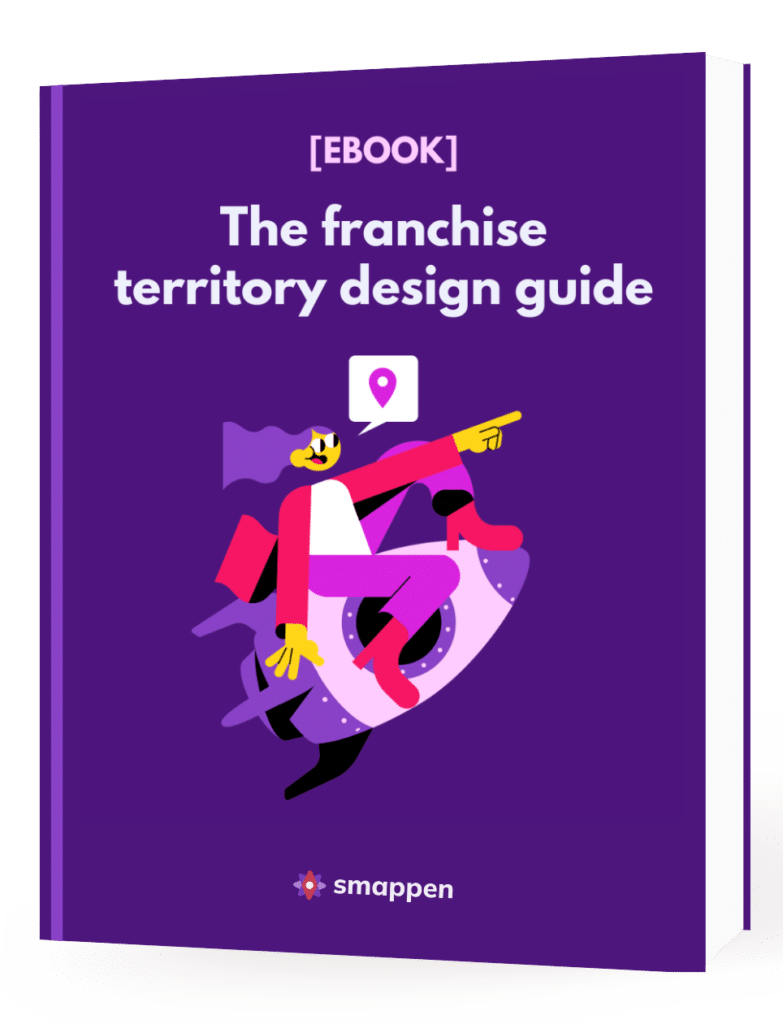Expanding your brand through franchising? Or maybe diving into the franchise world yourself? Either way, getting the territory size just right is like hitting that sweet spot in a game of darts—it’s crucial and can totally make or break your success.
Let’s dive into the nuances of determining the right size for a franchise territory, highlighting the importance of balancing between too small and too large, and offering insights into managing territories in large cities.
What is the right size for a territory?
So, what’s the magic territory size? Does such a size even exist? What are the potential pitfalls of choosing a territory that is either too small or too large? These are all significant questions that reveal the complexity of the issue.
Determining the optimal size for franchise territories is far from a straightforward process. However, drawing on the experiences of our customers and the knowledge of experts, we’ve been able to compile a set of guidelines to help you navigate this challenge.
Is there a minimum size for a franchise territory?
Each territory should offer enough potential for the franchise to succeed. An undersized territory is a setup for failure, making it crucial for franchisors to define territories based on quantified key success factors.
The minimum size for a territory, therefore, is basically the smallest area that meets your key success factors, ensuring that your franchise can thrive.
Dr. Tom DuFore’s advice:

We asked Dr. Tom DuFore for his expertise on this topic, as founder and CEO of Big Sky Franchise Team, an award-winning consulting firm specializing in helping growth-minded entrepreneurs franchise their businesses. He emphasizes the importance of getting the size right from the beginning, and to not hesitate to adjust and expand territories to ensure franchisee success.
“One of the mistakes I’ve observed is when a franchisor, starting as an emerging brand, initially sets territories that are too small. You really want your first franchisees to be successful. If you figure out the initial territories are too small, don’t hesitate to go back and expand those territories to adjust accordingly.”
What are the risks of a large territory?
Now, you might think, “Why not just give out massive territories? More land, more opportunities, right?” Well, not exactly. Going big can indeed offer more potential, but it can also bring additional costs and decrease the effectiveness of market penetration.
Your typical catchment area or typical service area will help you set the limits and avoid sizing a territory above its reachable market:
- For brick-and-mortar spots, the catchment area is crucial; potential customers are unlikely to travel beyond this area, leading to low market penetration and wasted revenue potential for territories sized beyond this limit.
- For on-the-go businesses, operating beyond a maximum serviceable area can either increase operating costs and reduce profit margins or leave potential customers unserved due to the impracticality of servicing these areas.
Dustin Ingle’s advice:

Dustin Ingle, CEO of Insulation Commandos, boasts extensive experience in developing franchises. Notably, he contributed to the growth of home service brands during his tenure as a Franchise Development Director at BELFOR Franchise Group. He offers his expert advice for mobile businesses:
“In rural areas, you may reach your target number of people with spread-out territories. However, it could be a three-hour drive from one end to the other. For a new franchisee with a single truck, starting out with a drive time radius of one hour is the furthest they should go to avoid additional costs.”
The case of large cities: How to size territories in a big city?
Big cities are a whole different beast. They present unique challenges and opportunities for franchisors when it comes to territory sizing. The dense population and diverse demographics require a nuanced approach to ensure that territories are viable and competitive.
So, how do you slice that urban pie without making a mess?
Option 1: cutting a city into slices
It’s a complex exercise. Indeed, each city is heterogeneous, with urban areas, outskirts, affluent neighborhoods, and popular neighborhoods, each with different characteristics. It’s not easy to create equivalent zones under these conditions!
One possible strategy to define territories in a large city: dividing it like a cake.
Here, the goal is to cut equivalent portions in terms of potential and characteristics. For example, a city can be sliced like a pie chart, so that each franchisee can have a part in the city center and a part in the suburban area. Don’t aim for perfection, aim to be fair; that’s already very good.
Option 2: developing multi-unit franchisees
Then there’s the path of grooming multi-unit franchisees.
This strategy allows a single franchisee to operate multiple units within different parts of the city, leveraging their understanding of the local market across several territories.
Multi-unit franchising can lead to some sweet benefits like cost savings, stronger marketing, and a beefier brand presence within the city.
Customer testimonial:
MICHAEL DORE
Operator of MCD Associates, LLC, a K9 Resorts multi-franchisee
Michael, a native of Houston, is at the helm of MCD Associates, LLC, managing two K9 Resorts franchise locations within the Greater Houston area. Leveraging his extensive knowledge of the local terrain, and customer habits and demographics, he is well-positioned to drive growth for the franchise. Additionally, Michael harbors ambitions to further develop his business by expanding the franchise to additional locations.
Option 1 or 2, the choice is yours, but you must know that both options require careful planning and a deep understanding of the local market dynamics. You’ve got to factor in demographics, consumer habits, and who you’re up against to tailor territories that are set up for success.
Now, time to draw your franchise territories
In conclusion, sizing franchise territories requires a delicate balance between providing enough market potential for the franchisee to thrive and avoiding the pitfalls of overly ambitious or restrictive territory design.
Leveraging territory mapping software can greatly aid in this endeavor.
With platforms such as Smappen, you’re able to sketch an initial outline of your territories, effortlessly visualize them, and refine your approach to establish the ideal territories that will enable your franchisees to flourish.

